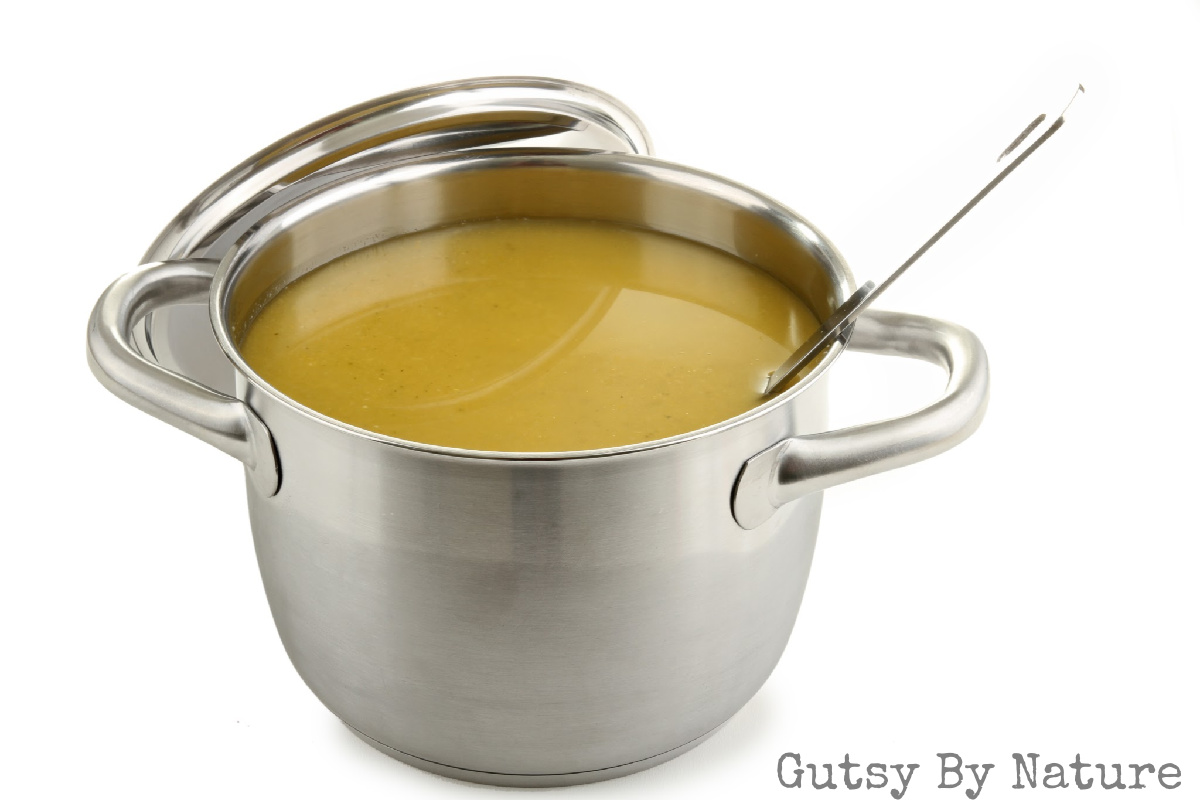
Bone broth. I recently realized that it is no longer accurate to say that bone broth is “having a moment.” Of course, that has always been true! The idea of making a long-simmered broth or stock from bones and other scraps and then using it as both a culinary ingredient and health-promoting tool as been part of traditional cultures around the world for as long as man has been using fire and hunting animals. It is really only in very recent generations in Western society, when food became so plentiful that we lost the drive to squeeze out every drop of nourishment from it, that broth making fell out of favor… but only temporarily.
That resurgence is now in full swing and to the point that when I tell my clients I want them consuming bone broth every day to support their body’s natural healing ability, they are not the least bit surprised! They’ve already seen it on their store shelves, heard about its potential benefits from mainstream health outlets like Dr. Oz or Shape magazine, or had a friend tell them that it is the key to their vibrant skin.
But, they still have plenty of questions and this post is intended to be a definitive guide to answer all of them in one place. I’ve written it like how the conversation usually unfolds with my clients. Where relevant, I’ve woven in some links to other websites and other resources for those who want more information or specific recipes. Feel free to explore these at your leisure.
The whys and hows of AIP bone broth
One of the first healing foods I want you to add to your diet is bone broth. The potential health benefits of bone broth are many and have been well documented. Chris Kresser has written a very thorough definitive guide here, covering everything from skin health to mood and sleep. It helps your immune system return to normal functioning through several different mechanisms, including building a healthy gut lining and providing many key minerals and amino acids. You could spend lots of money buying these as separate supplements, or you can just get them right from a natural source by drinking bone broth!
How much should I consume? Start by making a commitment to have at least one cup per day. It can be sipped “straight” or you can consume it primarily as an ingredient in soups or stews or other dishes. If one cup a day feels good, you can increase that to two cups.
You can make your own bone broth, but to get started you might want to buy some. Be sure to carefully check ingredient labels to make sure it is AIP compliant.
What should I look for on the ingredient label? Look for non-compliant flavorings and spices. Some popular brands contain black pepper, so those are out during the AIP elimination phase. You also want to watch for the word “spices” since we can’t know for sure what that means.
Where will I find good bone broth to buy? Check the freezer and refrigerated section of your grocery store first. There may be local or regional broths there. You’ll also probably find some brands in shelf stable packaging on the shelves with canned soups, but I prefer the fresh or frozen broths for taste and for nutritional value. Either way, remember to read the ingredient label every time as formulations do change without warning. There are many brands, including some that you can get delivered.
Buying broth is expensive! I think I want to make my own. Where do you get the bones? The majority of the bones I use for broth making come from our dinner scraps. I keep a gallon ziplock bag in the freezer and add as we go. Every couple weeks I roast a whole chicken and we eat bone-in pork chops, lamb chops, and beef on a regular basis. Start collecting your bones now and in a couple weeks, you’ll have a freezer stash too!
If you want to jump right in, check your grocery store, butcher, and local farmers. My farmer also sells chicken feet, which I keep on hand to throw in whenever I don’t have a lot of fresh bones. We also get a 1/4 cow once a year and I always ask for the extra bones.
Do I need to make sure the bones are grass-fed or organic? Get the best quality bones you can, but don’t let it stop you if that is out of reach. Any bone broth is going to be better than no bone broth!
Can you give me a bone broth recipe? Here is a good basic recipe for stove top and another one for doing it in an Instant Pot. If you are more of a visual person, you might like this video.
But I have to fess up and tell you that I don’t use a recipe at all. I simply put whatever bones I have on hand in my Instant Pot, add water to cover them plus a splash of vinegar, and seal it up with the pressure set to high for 120 minutes. When it is done, I let the pressure naturally release and switch over to “keep warm” mode for as little as 30 minutes or as long as several hours, depending on when my schedule and other activities lets me get back to it. Then, I strain and put the resulting broth into mason jars, sort the bones to discard any that are crumbling and save the rest to use again.
What?! You can use the bones more than once? Yep! I usually get three or four uses out of the bigger bones and at least two out of the smaller ones. I do find the best broth comes when I use some first-time bones, so I try to include a mixture.
I don’t have an Instant Pot, but I do have a slower cooker. Can I use that? Sure! Here is a recipe.
How should I store my broth after I make it? I pour my broth while it is still hot into glass mason jars and cover them with lids like these and store in the refrigerator. I use glass rather than plastic because then I don’t have to worry about any chemicals leaching into my hot broth. If I ever do need to put the broth in plastic for some reason, I only put it in the plastic when the broth is completely cold.
Can I freeze the broth? You can, but if you are drinking a cup or two a day, you may not ever need to. If I do find myself with excess broth because I’m traveling out of town or something else has happened, I freeze it in plastic containers that I save from other sources. You can freeze in glass, but you must use jars without “shoulders” and leave plenty of headspace for the broth to expand or else it will break. Another option is to freeze in silicone molds.
I put my broth in the fridge and a thick layer of something hard formed on top. What is this? Should I eat it? That is the fat. I am always pleased to see that form on my jars because it helps to keep the liquid broth below longer as it is “sealed” away from oxygen by that fat cap. When I open the jar to start consuming it, I remove the fat cap and feed it to my dog (it makes her coat nice and shiny!). I don’t actually recommend that people eat it, especially people with chronic health conditions because it has been exposed to so much heat that it may have become oxidized.
I heard that good bone broth is supposed to “gel” after it gets cold but mine didn’t. What did I do wrong? Nothing. A broth that doesn’t actually gel up is still good for you, it just isn’t quite as high in collagen content as broth that does get gelatinous. I would estimate that my broth probably only gels one out of every three times… and I don’t worry about it.
I made broth and I’m trying to consume it like you recommended, but it seems to be making me feel worse. What’s up with that!? I thought this stuff was good for you… It is good for you, but if you have histamine intolerance, you may find that long cooked bone broths are histamine triggers. One way to address that is to shorten your cook time. Another is to make sure you consume bone broth only when your overall “histamine cup” is not full. And of course, we want to work on improving your body’s ability to clear histamine by getting to the root cause and addressing that.
What if I have SIBO? I’ve heard bone broth is high FODMAP. There are two ways that bone broth can potentially be high FODMAP and therefore troublesome for some people with SIBO. Most obviously, it could include high FODMAP vegetables like onions in high enough quantity to bother you, even after they have been strained out. But another way it could be problematic for SIBO is if bones that include large amounts of cartilage are used. This cartilage contains a polysaccharide that may irritate your system. This can be easily avoided by using only marrow bones.
I feel good consuming it, but I can’t stand the taste! What should I do? One of my favorite ways to turn broth that tastes so-so into something yummy, is by making it into a green broth. You may also want to tweak the way you make your broth. If you are using beef bones, you’ll probably find a better flavor if you roast them first instead of using them raw. If you are using primarily chicken bones, try throwing in some onions and celery.
Also, keep in mind that your tastes will change over time, especially as your body figures out how good this stuff is for you! Eventually, you might even find yourself craving it!
Bone broth by mail from Captain Soup
As I mentioned above, the best pre-made broth is not going to be found in a box or a can on a shelf, but in the refrigerator or freezer. If your grocery store doesn’t carry any, one option for people in the United States is to order from Captain Soup. If it is your first time placing an order, be sure to use coupon code GUTSY for $10 off.
[NOTE: I am an affiliate for this company which means I get a commission for referring you if you use the above link. I’m also a happy customer!]
Click to Pin it!




5 replies on “The Definitive Guide to AIP Bone Broth”
[…] also saved the carcass and all the bones and made some of the most delicious bone broth I’ve ever tasted! Mission “nose-to-tail” eating […]
[…] Bone broth: It helps your immune system return to normal functioning through several different mechanisms, including building a healthy gut lining and providing many key minerals and amino acids. (9) […]
Hi, can you have grass fed bone broth on aip diet?, because of the onions & other veggies, pepper, etc..
You need to check ingredient labels or modify any recipes to omit non-AIP ingredients. If the label or recipe includes a nightshade vegetable (like tomatoes) or spices (like pepper), then it would not be AIP.
this is helpful as i prep for winter soups.